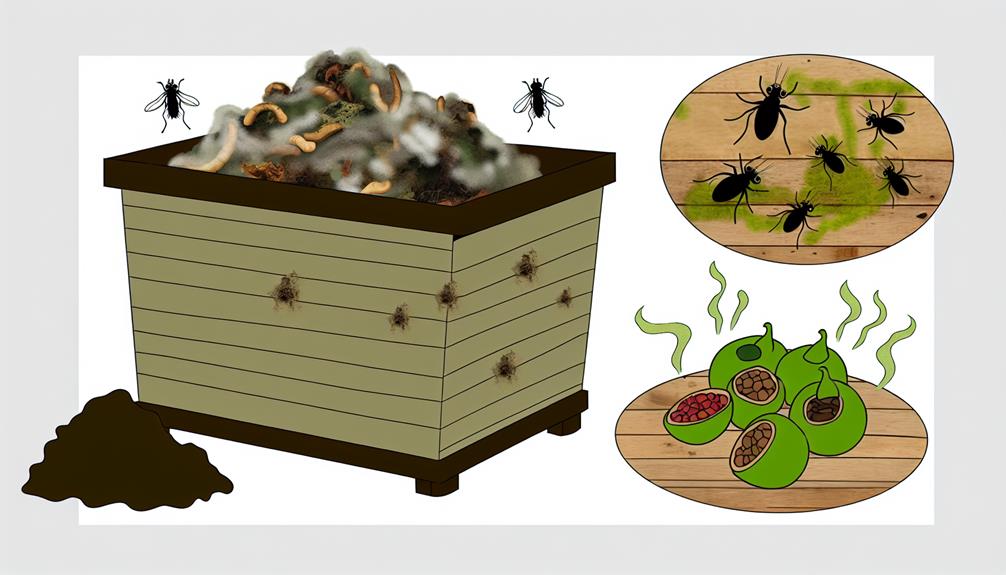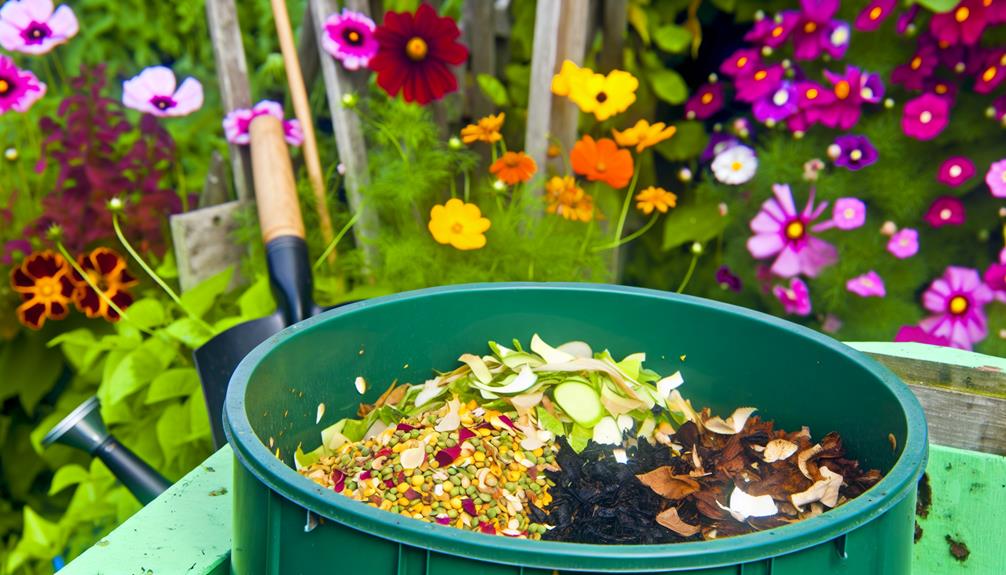

Yes, you can compost split peas. They are rich in nitrogen, which is crucial for a healthy compost pile. Just make sure you rinse them well and mix them with other compost materials like greens and browns to balance the decomposition process. Cooking or crushing them can speed up their breakdown.
Be cautious, as split peas can attract pests; covering your compost and turning it regularly can help deter them. Maintaining proper moisture levels and aeration will also promote effective composting. By following these tips, you’ll enhance soil quality for thriving plants and healthy growth. Discover more about efficient composting methods ahead.
Split peas are simply peas that have been dried, peeled, and split in half. When you’re thinking about these little legumes, it’s important to understand their properties and nutrient content.
Split peas belong to the legume family, which means they’re packed with beneficial nutrients and have specific characteristics that make them unique. You’ll find that split peas are rich in protein, fiber, vitamins, and minerals. Their legume properties include a high protein content, making them a valuable addition to your diet.
They also contain essential amino acids, which help your body function at its best. The fiber in split peas aids digestion and promotes a healthy gut, which is vital for overall well-being.
But it’s not just about the nutrients they provide to you. When considering composting, split peas bring their rich nutrient content into the mix, enriching your compost pile with essential elements. The breakdown of these legumes can help create a nutrient-dense compost, beneficial for your garden.
Also Read: Can You Compost Broccoli?
When you add split peas to your compost, you’re enriching it with essential nutrients that can greatly enhance soil quality. Split peas are packed with proteins, vitamins, and minerals that break down in your compost pile, contributing to soil enrichment and improving plant health. These nutrients not only boost the fertility of your soil but also support a thriving garden ecosystem.
Here are some key nutritional benefits of adding split peas to your compost:
When composting split peas, you might face some potential drawbacks. These peas can attract unwanted pests to your compost pile, and they often decompose at a slower rate than other materials.

To manage these issues, make sure your compost is well-balanced and regularly turned.
Composting split peas can attract unwanted pests if not managed properly. If you’re not careful, you might find your compost heap becoming a buffet for rodents, insects, and other critters.
Implementing effective pest management strategies is essential to keep your compost healthy and thriving. Here are some practical pest deterrents worth exploring:
Split peas have a slow decomposition rate, which can be a potential drawback in your composting efforts. When you add split peas to your compost pile, they tend to break down more slowly compared to other organic materials. This means they might linger in your compost longer than you’d like, potentially delaying the overall composting process.
To mitigate this, consider using different split varieties and cooking methods. For example, cooked split peas decompose much faster than their uncooked counterparts. By boiling the split peas before adding them to your compost pile, you speed up their breakdown. This simple step can greatly enhance the efficiency of your composting process.
You might also want to mix split peas with other high-nitrogen materials like grass clippings or kitchen scraps. This can help balance the carbon-to-nitrogen ratio in your compost pile, promoting faster decomposition.
Remember to turn your compost regularly, as this aerates the mix and further accelerates the breakdown of all materials, including split peas.
Also Read: Can You Compost Tamarind?
To compost split peas effectively, start by rinsing them thoroughly to remove any debris.
Next, mix the prepared split peas with other compost materials like vegetable scraps and yard waste.
Make sure you turn the compost regularly to maintain proper aeration and moisture levels.
Before you begin composting split peas, make sure they’re free from any sauces or seasonings. This is important because added ingredients can disrupt the composting process.
Split peas often come from various cooking methods and soaking techniques. If you’re using leftover split peas, confirm they haven’t been soaked in salty or sugary solutions. These additives can attract pests and slow decomposition.
To prepare your split peas for composting, follow these steps:
When you’re ready to compost split peas, start by layering them with green and brown materials to create a balanced compost heap. Green materials include kitchen scraps, grass clippings, and, of course, split peas. Brown materials, like dried leaves, cardboard, and straw, provide carbon, essential for the composting process. This balance is vital for ideal soil composition and garden health.
First, create a base layer of coarse brown materials to guarantee proper aeration. Next, add a layer of green materials, including your split peas. Continue alternating green and brown layers, aiming for a ratio of roughly three parts brown to one part green. This mix helps maintain the right moisture level and encourages the activity of beneficial microorganisms.
Turn your compost pile every few weeks to aerate it, which speeds up decomposition. Monitor the moisture level; it should feel like a damp sponge. If it’s too dry, add water; if too wet, mix in more brown materials.
Within a few months, your split peas and other compost materials will break down into nutrient-rich humus. This humus will enhance soil composition and promote garden health, creating an thriving environment for your plants.
Also Read: Can You Compost Wood Scraps?
For a balanced compost, make sure to mix green materials like split peas with brown materials such as dry leaves or straw. The balance between green (nitrogen-rich) and brown (carbon-rich) materials is essential for effective composting.

Split peas, which come in various types and varieties, provide an excellent nitrogen boost. Whether you’ve cooked them using different methods or have raw leftovers, they can contribute valuable nutrients to your compost pile.
To achieve a well-balanced compost, follow these tips:
Also Read: Can You Compost Cauliflower Scraps?
While composting is an excellent way to recycle organic waste like split peas, you might be interested in exploring other eco-friendly disposal methods.
One great alternative use for split peas is incorporating them into creative recipes. Split peas can be transformed into delicious dishes like split pea soup, veggie burgers, or even savory pancakes. By doing so, you’re not only reducing waste but also adding nutritional value to your meals.
If cooking isn’t your forte, consider using them as a natural fertilizer. Simply grind the split peas into a fine powder and sprinkle it around your plants. This provides a slow-release source of nutrients, helping your garden thrive without synthetic chemicals.
Another innovative option is to use split peas in crafting. Create homemade heating pads by filling fabric pouches with split peas, then sewing them shut. These pads can be microwaved for a soothing, reusable heat source.
Yes, split peas can attract pests if added to compost. For guaranteeing pest prevention, make sure they’re well-mixed with other materials. Common pest types include rodents and insects. You’ll keep your compost healthy by managing its balance properly.
You’re wondering about the decomposition rate of split peas. With high microbial activity in your compost, split peas can break down in about 3-6 months. It’s a great addition that helps your compost community thrive!
You don’t need to cook split peas before composting. Their nutrient content will still enrich the pile. Just make sure you mix them well with other composting methods to help create a balanced, thriving compost community.
Yes, split peas can cause odors in the compost pile if you don’t maintain the proper compost moisture and aeration balance. Make sure to turn your pile regularly and monitor its moisture to keep it fresh.
Your plants will thrive with split pea compost! It enriches soil nutrients, boosting plant health. Leafy greens and legumes, in particular, benefit greatly. You’ll see your garden flourish, creating a sense of community and belonging.
Composting split peas is a practical choice, offering nutritional benefits for your compost pile. To maximize effectiveness, balance them with carbon-rich materials like leaves or paper.
Watch for potential issues like odor or pests, and rotate your compost regularly to guarantee proper aeration.
If composting isn’t feasible, consider using split peas in other ways, like cooking or feeding animals.
By following these tips, you’ll contribute to a healthier, more productive compost system.

Don't let aphids, slugs, and caterpillars ruin another plant. Take back control with simple, natural methods that actually work.